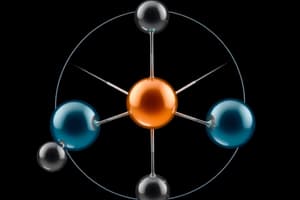Podcast
Questions and Answers
What type of molecular structure results from the combination of two atomic orbitals?
What type of molecular structure results from the combination of two atomic orbitals?
- Planar
- V-shape
- Trigonal bipyramidal
- Tetrahedral (correct)
When is a molecule considered stable based on the number of bonding and antibonding molecular orbitals?
When is a molecule considered stable based on the number of bonding and antibonding molecular orbitals?
- When Na is greater than or equal to Nb
- When Na is equal to Nb
- When Na is greater than Nb
- When Na is less than Nb (correct)
H2, N2, O2, and Li2 are classified as what type of molecules?
H2, N2, O2, and Li2 are classified as what type of molecules?
- Heteronuclear diatomic molecules
- Homonuclear triatomic molecules
- Homonuclear diatomic molecules (correct)
- Heteronuclear triatomic molecules
What describes the relationship between bond order and bond length?
What describes the relationship between bond order and bond length?
O-nitrophenol is characterized by which type of hydrogen bonds?
O-nitrophenol is characterized by which type of hydrogen bonds?
Which condition is required for a molecule not to exist?
Which condition is required for a molecule not to exist?
Identifying which of the following molecules does not exist?
Identifying which of the following molecules does not exist?
What is true regarding the nitrogen molecule?
What is true regarding the nitrogen molecule?
The magnitude of hydrogen bonding depends on which factor?
The magnitude of hydrogen bonding depends on which factor?
Which of the following molecules can form a hydrogen bond with hydrogen?
Which of the following molecules can form a hydrogen bond with hydrogen?
Flashcards are hidden until you start studying
Study Notes
Molecular Orbitals and Bonding
- When two atomic orbitals combine, they can form either a bonding or an antibonding molecular orbital
- A bonding orbital has lower energy than the atomic orbitals and is occupied by electrons that are shared between the two atoms, resulting in a bond
- An antibonding orbital has higher energy than the atomic orbitals and is not occupied by electrons in a stable molecule, resulting in a reduction in bond strength
Molecular Stability
- A molecule is stable if the number of bonding molecular orbitals (Nb) is greater than the number of antibonding molecular orbitals (Na)
- This is because the bonding orbitals are lower in energy, and the electrons in them are more stable
Bond Order
- Bond order is a measure of the strength and stability of a bond between two atoms
- It is calculated as the difference between the number of electrons in bonding orbitals and the number of electrons in antibonding orbitals, divided by 2
- Higher bond order indicates a stronger, shorter bond
- A molecule with a bond order of zero does not exist (Na = Nb)
Homonuclear and Heteronuclear Diatomic Molecules
- A homonuclear diatomic molecule contains atoms of the same element (ex: H2, O2, N2, Li2)
- A heteronuclear diatomic molecule contains atoms of different elements (ex: CO, NO, HCl)
Intermolecular and Intramolecular Hydrogen Bonds
- A hydrogen bond is a type of intermolecular force that occurs between a hydrogen atom bonded to a highly electronegative atom (like O, N, or F) and a lone pair of electrons on an adjacent atom
- Intermolecular hydrogen bonds occur between molecules (ex: water molecules)
- Intramolecular hydrogen bonds occur within the same molecule (ex: o-nitrophenol)
Properties of Hydrogen Bonding
- Hydrogen bonding is a stronger type of intermolecular force compared to van der Waals forces
- It affects the boiling point of liquids and the melting point of solids
- The magnitude of hydrogen bonding is dependent on the strength of interaction between the hydrogen atom and the electronegative atom
Existence of Molecules
- Not all combinations of atoms result in stable molecules
- For example, He2 has a bond order of zero and therefore does not exist
- H2, O2, and N2 all exist due to their stable bond orders
Nitrogen Molecule (N2)
- The nitrogen molecule (N2) is diamagnetic
- The bond order of N2 is 3.
- N2 has a total of 14 electrons
Oxygen Molecules
- The bond order of O2 is 2 and is a paramagnetic molecule.
- O2- has a bond order of 1.5
- O22+ has a bond order of 2.5
- O22- has a bond order of 1
- Shorter Bond Length corresponds to a higher bond order. Thus, O22+ (bond order 2.5) has the shortest bond length.
Molecular Shape
- IF7 has a pentagonal bipyramidal structure, meaning it has 5 fluorine atoms arranged in a pentagonal plane, and 2 fluorine atoms at the apical positions above and below the plane
- Square planar is not a possible structure for IF7 .
Studying That Suits You
Use AI to generate personalized quizzes and flashcards to suit your learning preferences.




